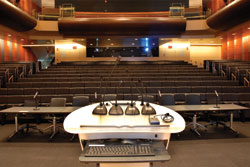

Virtual Education: A Blueprint for Distance Learning
It seems pro AV and distance learning were made for each other. But that wasn’t always the case. In the past, classroom technology and AV conferencing were mostly analog, disconnected things.
Multiple cameras and broadcast quality AV output are just some of the highlights in the 499-seat Blau Auditorium at the University of Michigan’s Ross School of Business.
Credit: University of Michigan
It seems professional AV and distance learning were made for each other, but that wasn’t always the case. In the past, classroom technology and AV conferencing were mostly analog, usually disconnected technologies. Meanwhile desktop software had static documents down pat, but choked on video.
Lately, near-total digitization has brought the two together, and the recent coming of age of lecture-capture systems, combined with the ubiquity of streaming video, makes today’s tech-driven classroom just another engine in the explosion of information available anytime, anywhere on the Web.
Experts say distance learning is also evolving from synchronous (live) conferencing to asynchronous (on-demand) access that suits today’s flexible teaching and learning styles. It is also becoming more distributed, taking place increasingly in small conference rooms and on personal electronic devices, though AV-heavy auditoriums are still the main point of origin. One technical reason: cheaper bandwidth from broader adoption of the H.264 video-compression standard.
Meanwhile, VoIP continues to push aside plain old telephone system (POTS) lines, making audio conferencing more intelligent, malleable, and affordable. Further out on the cutting edge is video delivered over the same networks, a highly flexible medium for IPTV.
The ultimate goal is what Alan Greenberg, senior analyst and partner at Wainhouse Research, calls the “smart” or “intelligent” classroom, fitted with technology that virtually disappears. “That would be the classroom where the instructor walks in and they teach,” he says. “It just doesn’t exist, even though the vendors want it to.”
Nonetheless, the goal is reachable by those willing to sweat the design details. “They need to think long and hard about how to make the technology, and the experience of using it, as transparent as possible,” Greenberg says. “If it becomes successful, it becomes part of the DNA of the organization.”
Virtual Collaboration
As AV pros know, technologies such as projectors, document cameras, and computers play an increasingly central role in the classroom, while conferencing tools efficiently link remote locations in a virtual collaborative environment. As a result, “the line between remote and in-room becomes largely irrelevant,” says Robert Abbott, director of product management at Smart Technologies, a maker of whiteboards and other input devices. “Our philosophy is that distance learning is not about the one special room on our campus, it’s about every classroom.”
Even the meaning of “remote” is blurring. Wainhouse says that 50 percent of on-campus students at one state college who could have attended online courses in person chose instead to attend online. “They’re watching it from the dorm or the classroom,” Greenberg says.
As it has become in many corporations, video-conferencing has become a mandatory piece of distance learning. It’s what lets the instructor deliver to remote students an approximation of what those in the classroom see in person. “We really believe video has changed everything, and will really change the landscape of collaborative education,” says Dave Rubal, regional manager for federal unified communication at Cisco Systems.
High definition is the way to go, though that doesn’t have to mean expensive telepresence. “It requires far more expensive modification of the learning environment,” says Jim Smith, an audiovisual systems engineer at Polycom, a vendor of videoconferencing equipment.
The risk in large rooms, Smith says, is that something–pops and sputters from a speaker; a shadow thrown by a projector–will break the illusion on which telepresence depends. That’s why it makes sense for distance-learning designs to focus on content delivery instead of video endpoints. Besides, a decent HD system can approach the realism of basic telepresence without over-designed rooms and giant videowalls.
Still, telepresence has its place and doesn’t always require a million-dollar investment. “There are times when the quality of an experience is based on a connection that is, literally, face to face,” says Bob Lee, education solutions marketing manager for Cisco, which makes videoconferencing systems. “That’s not a larger room, but it’s a more capable room.”
Camera placement and operation are crucial to delivering a natural-looking experience to both local and remote viewers. Typically, an HD camera or two in the back of the room captures the instructor, while cameras in the front are directed on students. Camera placement and automation should mesh unobtrusively with each instructor’s style.
“Teachers are not TV news anchors,” says Lance Ford, an education advocate at Tandberg. “They’re not trained to look at the camera.” Ford adds that because teachers tend to mold their deliveries to the students in front of them, they shouldn’t have to play simultaneously to remote audiences. “It is just paramount that cameras and display devices are designed so that when you’re looking at one, you’re looking at both,” he says.










